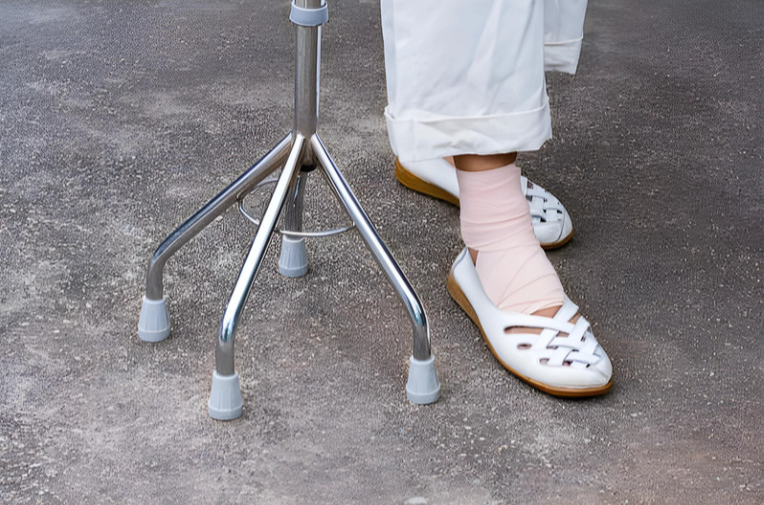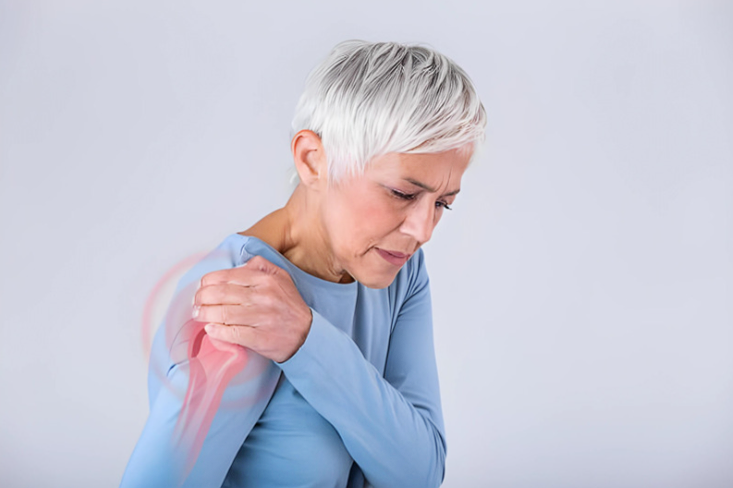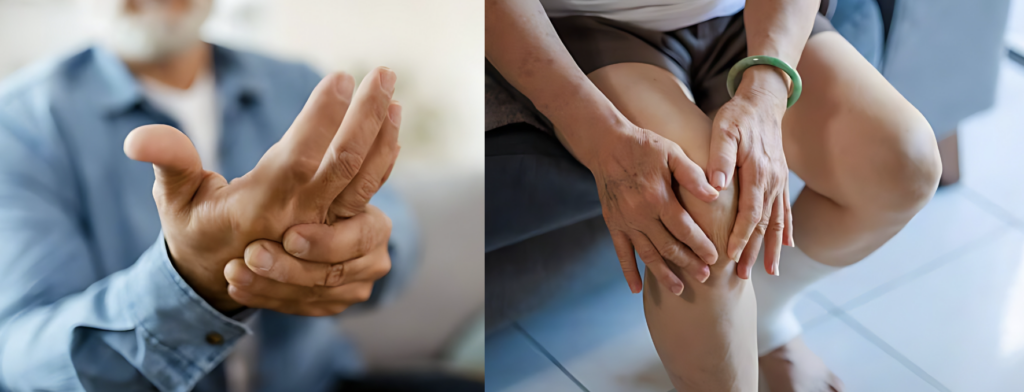Joint Health
What’s the Difference Between Osteoarthritis and Rheumatoid Arthritis?
While these illnesses affect the joints and share certain symptoms, they have unique underlying causes and require different treatment approaches.
Navigating various types of arthritis can be difficult, especially when distinguishing between different types such as osteoarthritis (OA) and rheumatoid arthritis (RA). In this article, we’ll look at the fundamental differences between osteoarthritis and rheumatoid arthritis, including their unique traits, symptoms, causes, and treatment options.
Understanding the differences between OA and RA is critical for educated decision-making and successful management, whether you are suffering from joint discomfort or simply want to learn more about these common disorders.
Understanding osteoarthritis
Osteoarthritis (OA) is a degenerative joint disease characterized by cartilage degradation, which causes pain, stiffness, and limited mobility. It is the most prevalent type of arthritis and usually affects weight-bearing joints such the knees, hips, spine, and hands. As cartilage deteriorates, bones may scrape against one another, resulting in further injury and the creation of bone spurs.
OA is frequently connected with aging, joint wear and tear, obesity, joint traumas, and genetics. The severity of osteoarthritis symptoms can vary and worsen over time, affecting a person’s quality of life. OA treatment focuses on treating symptoms, lowering inflammation, and increasing joint function using a mix of medicine, physical therapy, lifestyle changes, and, in some circumstances, surgery. Early diagnosis and treatment can help to decrease the progression of osteoarthritis and alleviate its symptoms.

Causes and risk factors of osteoarthritis
Osteoarthritis (OA) can develop due to a combination of factors, including:
- Aging: Aging raises the risk of OA because cartilage naturally degenerates over time.
- Joint overuse or injury: Repetitive stress on a joint, such as during sports or certain vocations, can cause cartilage damage and raise the risk of OA. Joint traumas, such as fractures or ligament rips, can also increase the risk of developing OA.
- Obesity: Excess body weight puts additional strain on weight-bearing joints including the knees and hips, raising the risk of OA development and progression.
- Genetics: Some genetic variables may increase an individual’s propensity to developing osteoarthritis. A family history of OA increases the chance of its development.
- Joint deformities: Congenital joint abnormalities or malformations can predispose people to OA by altering joint mechanics and increasing stress on the affected joints.
- Gender: Women are more likely than males to develop osteoarthritis, particularly after menopause, though the reasons for this gender difference are not entirely known.
- Joint diseases: Pre-existing joint problems, such as rheumatoid arthritis or gout, can raise the risk of secondary osteoarthritis in the affected joints.
- Bone density: Low bone density, often known as osteoporosis, can cause joint deterioration and raise the risk of osteoarthritis.
- Muscle weakness: Weak muscles around the joints may fail to offer enough support, putting additional strain on the joint structures and increasing the risk of OA.
By addressing these risk factors through lifestyle modifications, joint protection strategies, and appropriate medical management, individuals can reduce their risk of developing osteoarthritis or slow its progression.

Symptoms of osteoarthritis
Symptoms of osteoarthritis (OA) can vary depending on the affected joints and the severity of the condition. Common signs and symptoms include:
- Joint pain: Joint pain is persistent or intermittent discomfort in the affected joint(s) that worsens with activity and improves with rest.
- Joint stiffness: A decrease in range of motion in the affected joint(s), often after periods of inactivity or upon rising in the morning.
- Joint swelling: Joint swelling is the swelling or inflammation of the affected joint(s), which is frequently accompanied by warmth and discomfort.
- Crepitus: Crepitus is the sensation of grating, cracking, or popping within a joint during movement.
- Joint instability: The sensation of joint instability or weakness, especially during weight-bearing exercises.
- Reduced function: Difficulty carrying out daily activities that involve the use of the affected joint(s), such as walking, climbing stairs, or gripping objects.
It’s crucial to understand that osteoarthritis symptoms usually appear gradually over time and can increase with age or in response to particular activities. Early detection and treatment of symptoms can assist improve quality of life and avoid additional joint injury. If you suspect you have osteoarthritis or are suffering joint pain or stiffness, you should visit a healthcare expert for an accurate diagnosis and treatment plan.

Treatment options for osteoarthritis
Treatment options for osteoarthritis (OA) aim to alleviate symptoms, improve joint function, and slow down the progression of the disease. Depending on the severity of symptoms and individual circumstances, treatment may include:
- Medications: Over-the-counter pain medications including acetaminophen and nonsteroidal anti-inflammatory medicines (NSAIDs) can help alleviate discomfort and inflammation. To treat symptoms, prescription drugs such as corticosteroids or hyaluronic acid injections may be advised.
- Physical therapy: A physical therapist can create a personalized training regimen to enhance joint flexibility, strength, and range of motion. Stretching exercises, low-impact aerobic activities, and strengthening exercises can all help to support the damaged joints.
- Weight management: Maintaining a healthy weight can help relieve stress on weight-bearing joints including the knees and hips, reducing pain and decreasing the progression of OA. A well-balanced diet and regular exercise can help you manage your weight.
- Assistive devices: Canes, braces, and splints can help support and stabilize afflicted joints, reducing pain and increasing mobility.
- Joint injections: Injecting corticosteroids or hyaluronic acid directly into the afflicted joint can provide immediate pain and inflammatory alleviation, especially in people with moderate to severe OA.
- Surgery: In cases of severe joint damage and disabling symptoms that do not respond to conservative therapy, joint replacement surgery (e.g., knee or hip replacement) or arthroscopic surgery may be used to repair or replace damaged joint tissues.
- Lifestyle modifications: such as avoiding symptom-causing activities, employing joint protection strategies during daily activities, administering heat or cold therapy, and implementing relaxation techniques, can help control OA symptoms and enhance quality of life.
It’s essential for individuals with osteoarthritis to work closely with healthcare professionals to develop a comprehensive treatment plan tailored to their specific needs and goals. Regular monitoring and adjustments to treatment strategies may be necessary to effectively manage symptoms and maintain joint health over time.

Understanding rheumatoid arthritis
Rheumatoid arthritis (RA) is an autoimmune condition that causes chronic inflammation of the joints. In RA, the immune system mistakenly assaults healthy joint tissues, causing inflammation, discomfort, stiffness, and, eventually, joint damage and deformity.
Unlike osteoarthritis, which predominantly affects the cartilage and bone in the joints due to wear and tear, rheumatoid arthritis focuses on the synovium, the lining of the membranes that surround the joints. RA can affect a variety of joints across the body, including the hands, wrists, elbows, knees, ankles, and feet, and it frequently advances symmetrically, affecting the same joints on both sides of the body.
Rheumatoid arthritis can also cause systemic consequences that affect various organs and tissues, including the heart, lungs, eyes, and blood vessels, among others. To avoid joint damage and disability, rheumatoid arthritis must be diagnosed early and treated aggressively.
Causes and risk factors of rheumatoid arthritis
The exact cause of rheumatoid arthritis (RA) is unknown, but it is believed to involve a combination of genetic, environmental, and immunological factors. Here are some factors that may contribute to the development of RA:
- Genetics: Family history is a crucial factor in RA. Individuals with a family history of the condition are more likely to develop it themselves.
- Autoimmune Factors: RA is classed as an autoimmune illness, meaning that the immune system erroneously assaults healthy tissues in the body. In RA, the immune system attacks the synovium, the lining of the membranes that surround the joints, resulting in inflammation and joint degeneration.
- Environmental Triggers: Infections or exposure to specific toxins may cause the beginning of RA in people who have a genetic predisposition.
- Hormonal Factors: Hormonal alterations, particularly in women, can influence the development of RA. The condition is more common in women than in males, and hormonal changes, such as those seen during pregnancy or menopause, might influence disease activity.
- Smoking: Smoking is a major environmental risk factor for RA, especially in people with a genetic predisposition. Smokers are more likely to develop RA and exhibit more severe symptoms than nonsmokers.
- Obesity: Being overweight or obese has been related to an increased risk of developing RA, as well as contributing to disease severity and progression.
- Age: While RA can affect people of any age, it often begins between the ages of 30 and 60. Older age at the onset of symptoms may indicate a more severe type of the disease.
- Gender: Women are more likely than males to acquire RA, and the disease typically manifests at a younger age in women.
- Stress: While stress is not a direct cause of RA, it can increase symptoms and lead to disease flares in people with RA.
It’s important to note that while these factors may increase the risk of developing RA, not everyone with these risk factors will develop the disease, and RA can also occur in individuals without any known risk factors.

Symptoms of rheumatoid arthritis
Rheumatoid arthritis (RA) is characterized by inflammation of the joints, which leads to pain, swelling, stiffness, and eventual joint damage. The symptoms of RA can vary in severity and may come and go in episodes known as flare-ups. Here are some common symptoms of rheumatoid arthritis:
- Joint Pain and Stiffness: Persistent joint pain, especially in the morning or after periods of inactivity, is a defining feature of RA. Stiffness may be more evident in the morning but improves with activity during the day.
- Swelling and tenderness: Inflamed joints may feel swollen, red, and warm. Tenderness surrounding the damaged joints is also prevalent.
- Joint Stiffness: Stiffness in the joints, particularly after periods of rest or inactivity, is a hallmark of RA. This stiffness normally lessens with activity, but it may last longer during flare-ups.
- Fatigue: Many RA patients report persistent weariness, which may be unrelated to physical exertion or activity levels. Fatigue can have a substantial influence on everyday functioning and overall quality of life.
- Limited Range of Motion: Inflammation and joint injury can reduce the range of motion in afflicted joints, making it difficult to perform daily chores and activities.
- Systemic Symptoms: RA can impact the entire body, resulting in fever, weight loss, and overall malaise.
- Morning stiffness: which lasts longer than an hour, is a common RA symptom. This stiffness may impact several joints and improve with activity throughout the day.
- Symmetrical Joint Involvement: Arthritis usually affects joints on both sides of the body symmetrically. For example, if one knee is afflicted, it is likely that the other will suffer as well.
- Joint Deformities: Left untreated, RA can cause joint deformities and injury, resulting in changes in joint shape and function. This can result in major disability and impairment in severe circumstances.
- Numbness and Tingling: In some situations, RA causes nerve compression or inflammation, resulting in numbness, tingling, or weakness in the hands and feet.
It’s essential to consult a healthcare professional if you experience any of these symptoms to receive an accurate diagnosis and appropriate treatment. Early detection and management of RA can help prevent joint damage and improve long-term outcomes.

Treatment options for rheumatoid arthritis
Treatment for rheumatoid arthritis (RA) aims to manage symptoms, prevent joint damage, and improve overall quality of life. Here are some common treatment approaches:
- Medications:
- Disease-modifying antirheumatic drugs (DMARDs) such as methotrexate, hydroxychloroquine, and sulfasalazine are often prescribed to slow down the progression of RA.
- Nonsteroidal anti-inflammatory drugs (NSAIDs) like ibuprofen and naproxen can help reduce pain and inflammation.
- Corticosteroids may be used to provide short-term relief from inflammation and pain during flare-ups.
- Biologic DMARDs: These drugs, which include TNF inhibitors, IL-6 inhibitors, and T-cell inhibitors, target specific immune system components to reduce inflammation.
- Pain Management: Analgesics such as acetaminophen may be prescribed to relieve pain, but they do not treat inflammation.
- Physical Therapy: Exercises and physical therapy approaches can aid with joint function, flexibility, and muscle strength.
- Occupational Therapy: Occupational Therapists can recommend assistive devices and adjustments to help with daily duties and reduce joint strain.
- Lifestyle Changes: Maintaining a healthy weight, eating a balanced diet rich in anti-inflammatory foods, stopping smoking, and controlling stress can all help reduce RA symptoms.
- Surgery: In severe cases where joint damage is extensive, surgical procedures such as joint replacement surgery or synovectomy may be considered to alleviate discomfort and enhance mobility.
- Alternative Therapies: Acupuncture, massage treatment, herbal supplements, and mind-body practices such as yoga and tai chi can all help relieve RA symptoms. However, these solutions must be discussed with a healthcare physician before they are tried.
Treatment plans for RA are often individualized based on factors such as disease severity, overall health, and patient preferences. Regular monitoring and adjustments to treatment are typically necessary to effectively manage the condition over time.
Disclaimer: Please note that Discoverybody has taken great care to ensure that all information provided is comprehensive and up to date. However, you should not use this article as a substitute for the expertise that a licensed healthcare professional can offer. It’s always a good idea to talk to your doctor before taking any medication.
Sources Expanded:
Branch, N. S. C. A. O. (2023, December 15). NIAMS Health Information on Osteoarthritis. National Institute of Arthritis and Musculoskeletal and Skin Diseases. https://www.niams.nih.gov/health-topics/osteoarthritis
Causes of and Risk Factors for Osteoarthritis. (2018, September 17). Healthline. https://www.healthline.com/health/osteoarthritis-risk-factors#risk-factors
Professional, C. C. M. (n.d.). Osteoarthritis. Cleveland Clinic. https://my.clevelandclinic.org/health/diseases/5599-osteoarthritis
Osteoarthritis – Diagnosis & treatment – Mayo Clinic. (2021, June 16). Mayo Clinic. https://www.mayoclinic.org/diseases-conditions/osteoarthritis/diagnosis-treatment/drc-20351930
Rheumatoid Arthritis: Symptoms, Diagnosis, and Treatment | Arthritis Foundation. (n.d.). https://www.arthritis.org/diseases/rheumatoid-arthritis
Rheumatoid Arthritis | CDC. (n.d.). https://www.cdc.gov/arthritis/types/rheumatoid-arthritis.html
Facr, S. K. M. R. M. M. F. (n.d.). Rheumatoid Arthritis (RA): Practice Essentials, Background, Pathophysiology. https://emedicine.medscape.com/article/331715-overview?form=fpf
Rheumatoid Arthritis Treatment Options | Johns Hopkins Arthritis Center. (2020, April 14). Johns Hopkins Arthritis Center. https://www.hopkinsarthritis.org/arthritis-info/rheumatoid-arthritis/ra-treatment/
Rheumatoid arthritis – Diagnosis and treatment – Mayo Clinic. (2023, January 25). https://www.mayoclinic.org/diseases-conditions/rheumatoid-arthritis/diagnosis-treatment/drc-20353653
Trusted Health, Wellness, and Medical advice for your well-being



